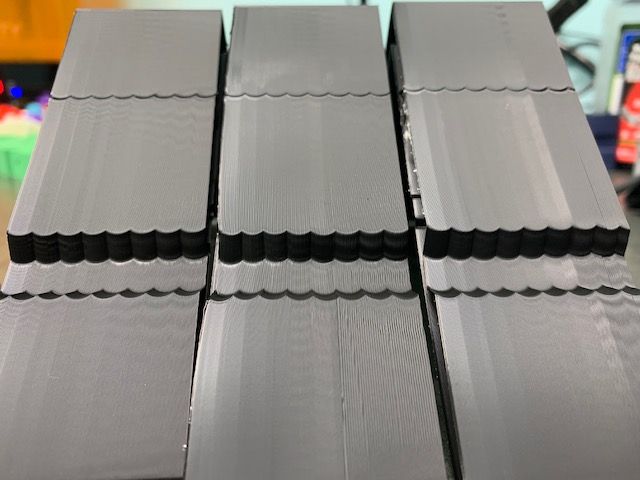What I have learned from not being a Jerk and using M593
-
In the quest to have the perfectly tuned printer I started playing with input shaping on my duet wifi. here is what I did to test and what machine I have
ender3 skeleton with .9 degree steppers, lighter bed, direct drive hero me5, dual axis, rails on x, rails on y, 16 tooth pulley (yeah I like to play with upgrades).
set
M203 X12000 Y12000 Z500 E1200 ; Set maximum speeds (mm/min)
M201 X3000 Y3000 Z250 E250 ; Set accelerations (mm/s^2)
M566 X300 Y300 Z20 E600 ;jerkand used the ringing_tower.stl from Klipper at .2 layer height in vase mode using a .35 nozzle.
all tests performed for 20 layers starting at 30, 45, 60, 75, 90, 105, 125, 140, 165mm/s (I usually print at 60)
the singular picture is with no input shaping... ghosting even at 30

here is a picture of no input shaping, input shaping DAA at 24 and input shaping DAA at 42 (which I calculated using math)

to my eyes any input shaping was better than nothing, but the calculated DAA 42 at 90mm/s print speed came out the best and it is really noticeable. still a tiny bit of ghosting left.
I still have ringing at Y which I don't think can be fixed? I think the math would come out a bit different as the ripples appear longer.
they are not as bad though as X was.What else could I try to improve quality? would the new beta code be different with ZVA?
is there a reason to tune Jerk values would it even help get rid of the last ripples?It is amazing the print quality you can achieve with a Duet... I have had this board for 5 years now and it has just been amazing.
Thanks,
Jim -
@jnofsinger the newer input shaping options are more sophisticated in the range of ringing frequencies they can cancel (we may remove DAA at some point in the future if the others turn out to be better in all regards). Worth a try for sure. What we can't say is will definitely produce further, visible, improvements!
-
@jnofsinger the newer forms of input shaping supported in firmware 3.4beta5 give better results than DAA did.
-
I am trying them now and see that ei2 did a much better job at getting rid of the X and Y overall. I noticed there is 1 place where the ripples are still around which I am testing with zvd/d next.
I assume there is a min speed which input shaping needs to happen? the low end of my tests are all the same at 30mm/s which isn't good.
Is there any tuning with speeds left after input shaping in general? I guess pressure advanced isn't something to use either or does that still help retraction?
Thanks for your time and effort in making reprap/duets very relevant and fun

-
@jnofsinger there is a "minimum acceleration" parameter in the M593 command. Lower values will cause input shaping to be used in more situations, at the expense of increased print time.
The default damping factor is 0.1, however on one of my machines I observed that setting the damping factor to 0.05 or 0 gave better results. In particular, EI shapers may work better with damping factor 0.
Pressure advance works separately from input shaping, although input shaping affects PA somewhat. So you may want to tune PA again when you have established what input shaper you want to use.